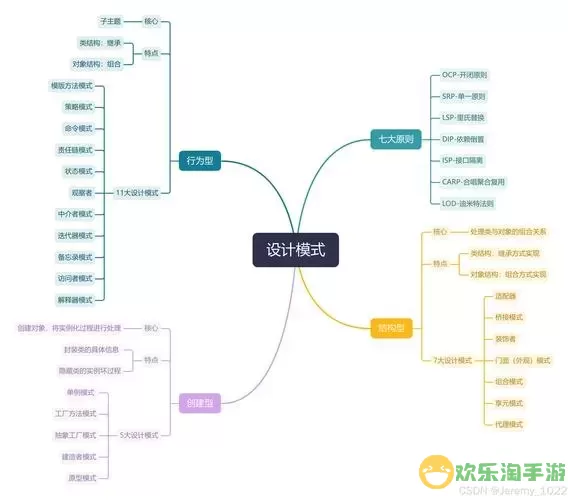发布时间:2025-03-15来源:互联网作者:新瑶
在软件开发中,设计模式作为一种可复用的解决方案,对构建高质量、易维护的代码架构起着至关重要的作用。特别是在 Java 这种面向对象的编程语言中,设计模式更是被广泛应用于项目开发中。本文将详细介绍一些常用的设计模式,并探讨它们在 Java 项目中的应用。

单例模式是一种确保某一个类只有一个实例,并提供一个全局访问点的设计模式。在 Java 中,可以通过私有构造函数和静态方法来实现单例模式。这个模式通常用于管理共享资源,如配置文件、数据库连接等。
public class Singleton {
private static Singleton instance;
private Singleton() {}
public static Singleton getInstance() {
if (instance == null) {
instance = new Singleton();
}
return instance;
}
}
在多线程环境下,需要注意线程安全,可以通过加锁等方式实现。
工厂模式是创建对象的设计模式,通过定义一个用于创建对象的接口,让子类决定实例化哪一个类。它主要分为简单工厂模式、工厂方法模式和抽象工厂模式。工厂模式的主要目的是将对象的创建与使用解耦,从而提升代码的灵活性和可扩展性。
public interface Shape {
void draw();
}
public class Circle implements Shape {
public void draw() {
System.out.println(圆形);
}
}
public class ShapeFactory {
public static Shape getShape(String shapeType) {
if (shapeType.equalsIgnoreCase(CIRCLE)) {
return new Circle();
}
return null;
}
}
观察者模式是一种一对多的设计模式,允许多个观察者对象监听某个主题对象的状态变化。当主题对象发生改变时,所有观察者会自动收到通知。在 Java 中,可以使用 `java.util.Observer` 和 `java.util.Observable` 实现这个模式。

import java.util.Observable;
import java.util.Observer;
public class WeatherData extends Observable {
private float temperature;
public void setMeasurements(float temperature) {
this.temperature = temperature;
setChanged();
notifyObservers();
}
}
public class CurrentConditionsDisplay implements Observer {
public void update(Observable o, Object arg) {
System.out.println(当前温度: + ((WeatherData) o).temperature);
}
}
装饰者模式允许向现有对象添加新的功能,而又不改变其结构。这种模式使用装饰类来包裹原有的类,从而增强其功能。在 Java 中,装饰者模式可以用于动态地扩展对象的功能,是实现开放-闭合原则的有效手段。
public interface Coffee {
String getDescription();
double cost();
}
public class SimpleCoffee implements Coffee {
public String getDescription() {
return 简单咖啡;
}
public double cost() {
return 5.0;
}
}
public abstract class CoffeeDecorator implements Coffee {
protected Coffee coffee;
public CoffeeDecorator(Coffee coffee) {
this.coffee = coffee;
}
public String getDescription() {
return coffee.getDescription();
}
public double cost() {
return coffee.cost();
}
}
策略模式是一种定义一系列算法,将每一个算法封装起来,并让它们可以互相替换的设计模式。策略模式使得算法的变化独立于使用算法的客户。它可以用来简化代码,减少条件语句。
public interface Strategy {
int doOperation(int num1, int num2);
}
public class OperationAdd implements Strategy {
public int doOperation(int num1, int num2) {
return num1 + num2;
}
}
public class Context {
private Strategy strategy;
public void setStrategy(Strategy strategy) {
this.strategy = strategy;
}
public int executeStrategy(int num1, int num2) {
return strategy.doOperation(num1, num2);
}
}
总结:设计模式在 Java 项目中为代码提供了灵活性和可维护性。通过合理运用这些模式,开发者可以减少重复代码,提高开发效率。在实际开发中,我们可以根据具体需求选择合适的设计模式,以实现更好的代码结构和更高的开发效率。

2024-03-14
魔兽三国塔防地图 魔兽三国塔防地图玩法攻略
巅峰极速gtr18 巅峰极速GTR18震撼发布
荣耀崛起农场 荣耀崛起庄园
古墓笔记和怀线 古墓笔记怀线探秘
猫和老鼠手游奥尼玛国服系列 猫和老鼠手游奥尼玛国服资讯
《脑洞大侦探》第2关中的隐藏物体在哪里
《COK列王的纷争》手游金矿采集指南
《英雄联盟手游》虎年限定皮肤介绍
剑与契约下架了么